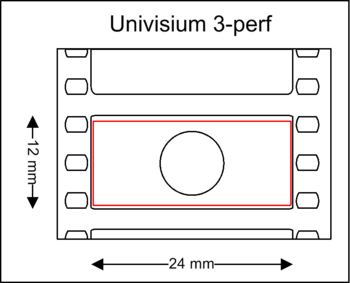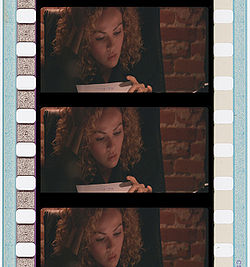
Univisium
Encyclopedia

Vittorio Storaro
Vittorio Storaro, A.S.C., A.I.C. is an Italian cinematographer.In 2003, a survey conducted by the International Cinematographers Guild judged Storaro one of history's ten most influential cinematographers.-Biography:...
, ASC
American Society of Cinematographers
The American Society of Cinematographers is an educational, cultural, and professional organization. It is not a labor union, and it is not a guild. Membership is by invitation and is extended only to directors of photography and special effects experts with distinguished credits in the film...
, AIC and his son, Fabrizio, to unify all future theatrical and television movies into one respective aspect ratio
Aspect ratio
The aspect ratio of a shape is the ratio of its longer dimension to its shorter dimension. It may be applied to two characteristic dimensions of a three-dimensional shape, such as the ratio of the longest and shortest axis, or for symmetrical objects that are described by just two measurements,...
of 2.00:1 (18:9). The proposed format also includes new standards for projection that maximize the efficiencies of the Univisium format.
The main proposal
In 1998, cinematographer Vittorio Storaro announced his plans for a new film format, originally to be called Univision, in an interview with International Photographer magazine. As Storaro stated in his written proposal "Recently, any movie - no matter how big or small, successful or not - will, after a very short life on the big screen, have a much longer life on an electronic screen. Today the Answer Print is made for both of these two different media. ...Having these two different media, with essentially two different aspect ratios, each of us (Directors, Production Designers, Cinematographers, Camera Operators, etc.) shares the nightmare of compromising the Composition of the Image. Looking through a viewfinder, a camera, or a monitor, we are always faced with at least two images of the same subject."Storaro opines that, in the future of cinema, all films will be photographed in either high-definition video for small, intimate digital projection theaters, or in 65 mm for "big audience... large screen" films. In the cinematographer's opinion, as all films will be one of the two formats, he suggests a common aspect ratio compromise of 2.00:1 (mathematical average of 65 mm 2.21:1 and HD 1.78:1) be adopted for all films, 65 mm theatrical, HD theatrical and television.
As he told American Cinematographer writer Bob Fisher, "I believe it is very important for audiences to see films exactly the way they were composed by the director and cinematographer. This is a solution."
35 mm Univisium camera proposal

By using a negative area similar to that of the Super 35 frame (which utilizes the full width of a 35 mm film frame "perf-to-perf" as opposed to traditional 35 mm which utilizes a smaller area of the 35 mm frame offset to the right to accommodate space for an optical soundtrack
Sound-on-film
Sound-on-film refers to a class of sound film processes where the sound accompanying picture is physically recorded onto photographic film, usually, but not always, the same strip of film carrying the picture. Sound-on-film processes can either record an analog sound track or digital sound track,...
) combined with 3-perf frame size (as opposed to standard 35 mm photography which uses four perforations per frame). The Univisium camera would use an aperture opening of 12mm x 24mm (.945" x .472") and three perforations per frame, which would eliminate the waste associated with 2.40:1 Super 35 mm photography (wherein nearly 50% of the frame is discarded) by creating a natural 2.00:1 aspect ratio utilizing the whole film area.
In addition to using the full film area, using three perforations per frame as opposed to four equates to using 25% less film for the same shooting time. With the traditional four perforations per frame, 35 mm film (at 24 frames per second) runs at 90 feet per minute (4 minutes 26 seconds per 400 feet of film), three perforations per frame runs at 67.5 feet per minute (5 minutes 56 seconds per 400 feet of film). This would mean each magazine of film would have 33% more shooting time and a production that shot the same overall length of time as a four-perforation film would use 25% less film.
The proposal also points out that the 2:00:1 aspect ratio can be achieved using standard spherical lenses, forgoing the need for anamorphic lenses, which are more expensive, slower (require more light) with less photographic depth of field
Depth of field
In optics, particularly as it relates to film and photography, depth of field is the distance between the nearest and farthest objects in a scene that appear acceptably sharp in an image...
than their spherical counterparts (which are higher quality, smaller, faster (require less light), with less aberrations (imperfections) associated with them. There are also a greater selection of spherical prime and zoom lenses than there are anamorphic lenses.
It is also pointed out that 3-perf will result in a quieter camera than 4-perf as there is less intermittent movement per frame.
The format also calls for shooting 25 frames per second, which eliminates problems associated with transferring film to video in the PAL
PAL
PAL, short for Phase Alternating Line, is an analogue television colour encoding system used in broadcast television systems in many countries. Other common analogue television systems are NTSC and SECAM. This page primarily discusses the PAL colour encoding system...
and SECAM
SECAM
SECAM, also written SÉCAM , is an analog color television system first used in France....
system and is still fairly simple to transfer to the NTSC
NTSC
NTSC, named for the National Television System Committee, is the analog television system that is used in most of North America, most of South America , Burma, South Korea, Taiwan, Japan, the Philippines, and some Pacific island nations and territories .Most countries using the NTSC standard, as...
video format.
35 mm Univisium projection proposal
Storaro suggests a renovation to standard film projectors to present a 3-perf frame and eliminate the need for an anamorphic print to be made (to optically squeeze the 2:1 3-perf aspect ratio into a 1.33:1 4-perf frame). As the image will fill the full film area (perf-to-perf) there is no room for a traditional optical soundtrack and Univisium requires two digital soundtracks, one for backup (which reside outside of the perforations on the edge of the film; DTSDigital Theater System
DTS is a series of multichannel audio technologies owned by DTS, Inc. , an American company specializing in digital surround sound formats used for both commercial/theatrical and consumer grade applications...
, SDDS
SDDS
Sony Dynamic Digital Sound is a cinema sound system developed by Sony. Compressed digital sound information is recorded on both outer edges of the 35 mm film release print. The system supports up to eight independent channels of sound: five front channels, two surround channels and a single...
, Dolby Digital
Dolby Digital
Dolby Digital is the name for audio compression technologies developed by Dolby Laboratories. It was originally called Dolby Stereo Digital until 1994. Except for Dolby TrueHD, the audio compression is lossy. The first use of Dolby Digital was to provide digital sound in cinemas from 35mm film prints...
). The projectors would run at 25 frames per second, just as the cameras do.
As a compromise to standard technology (for the time being), Storaro asserts that an anamorphic print can be made and presented in 24 frames per second with a digital and/or optical soundtrack.
Univisium in use
In just over a decade since Storaro presented his format proposal, only he has put portions of the proposal to practical use with the exception of a single film. Working with Technovision and Clairmont Cameras, both equipment providers have altered Arriflex 435 and 535B cameras for use on Storaro's films that use the Univisium aperture and 3-perf pull-down. In addition, Technicolor laboratories in Rome, London and Los Angeles also have the means to support the Univisium format. Although no film has utilized the full aspects of the proposal, especially with regard to the projection standards which have not been publicly adopted, Storaro has photographed a handful of recent films in the Univisium format.- TangoTango (1998 film)Tango is a 1998 Argentine tango film written and directed by Carlos Saura and photographed by acclaimed cinematographer Vittorio Storaro. The film is an Argentine and Spanish production.-Plot:...
(1998) - Goya in Bordeaux (1999)
- Picking Up the PiecesPicking Up the PiecesPicking Up the Pieces is a 2000 film directed by Alfonso Arau and starring Woody Allen.-Story:Allen plays Tex, a butcher who kills his unfaithful wife Candy, played by Sharon Stone. After cutting up the body, Tex buries most of her body parts in the desert in New Mexico. A blind woman accidentally...
(2000) - Frank Herbert's DuneFrank Herbert's DuneFrank Herbert's Dune is a 2001 3D video game based on the 2000 Sci Fi Channel miniseries of the same name. The game was not a commercial or critical success, and was the last product by Cryo Interactive, which went bankrupt shortly after the game's failure.As Paul, the son of the Duke Atreides's...
(2000) - Exorcist: The BeginningExorcist: The BeginningExorcist: The Beginning is a 2004 prequel to the 1973 film The Exorcist. This is the second version of the third Exorcist sequel. It was adapted by William Wisher Jr., Caleb Carr and Alexi Hawley, and directed by Renny Harlin...
(2004) - Zapata: El sueño del héroe (2004)
- Dominion: Prequel to the ExorcistDominion: Prequel to the ExorcistDominion: Prequel to the Exorcist is a 2005 supernatural horror film directed by Paul Schrader. It is a prequel to The Exorcist .-Plot:...
(2005) - Fair Trade (2006) - only Univisium film not shot by Vittorio StoraroVittorio StoraroVittorio Storaro, A.S.C., A.I.C. is an Italian cinematographer.In 2003, a survey conducted by the International Cinematographers Guild judged Storaro one of history's ten most influential cinematographers.-Biography:...
- Caravaggio (2007)
- Dare to Love Me (2010)
Additionally, Storaro has reframed many of his earlier widescreen releases for the 2:00:1 ratio upon DVD release, including Apocalypse Now
Apocalypse Now
Apocalypse Now is a 1979 American war film set during the Vietnam War, produced and directed by Francis Ford Coppola. The central character is US Army special operations officer Captain Benjamin L. Willard , of MACV-SOG, an assassin sent to kill the renegade and presumed insane Special Forces...
, Reds, and The Last Emperor
The Last Emperor
The Last Emperor is a 1987 biopic about the life of Puyi, the last Emperor of China, whose autobiography was the basis for the screenplay written by Mark Peploe and Bernardo Bertolucci. Independently produced by Jeremy Thomas, it was directed by Bertolucci and released in 1987 by Columbia Pictures...
. This has however proved controversial with many film enthusiasts, who believe that regardless of Storaro's attempt to unify all aspect ratios, films should be viewed in the ratio they were filmed in, without any cropping.

